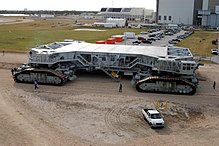Crawler-transporter

The crawler-transporter is a tracked vehicle used to transport the Saturn V rocket, the Saturn IB rocket during Skylab and Apollo-Soyuz Test Project, and now the Space Shuttle, from NASA's Vehicle Assembly Building (VAB) along the Crawlerway to Launch Complex 39.
The two crawler-transporters were designed by Bucyrus International and built by the Marion Power Shovel Co. at a cost of US$14 million each. When they were built, they were the largest tracked vehicles in the world.[1] The German Bagger 288 excavator is now the largest tracked vehicle in the world. While it is larger than the crawler-transporter, it is externally-powered and is more correctly described as a mining machine which can be moved. The crawler-transporters are self-powered, load-carrying vehicles, and they remain the world's largest self-powered tracked vehicles.
Specifications

The crawler-transporter weighs 6 million pounds (2,700 t) and has eight tracks, two on each corner. Each track has 57 shoes, and each shoe weighs approximately 900 kg (about one short ton). The vehicle measures 131 feet by 114 feet (40 m by 35 m). The height from ground level to the platform is adjustable from 20 to 26 ft (6 to 8 m), and each side can be raised and lowered independently of the other. The crawler uses a laser guidance system and a leveling system to keep the Mobile Launcher Platform level, with the tip of the external tank vertical within plus or minus 10 minutes of arc, while moving along the 5% upgrade to the launch site.[2] A separate laser docking system provides pinpoint accuracy when the crawler-transporter and Mobile Launch Platform are positioned in the VAB or at the launch pad.[3]
The crawler has 16 traction motors, powered by four 1,000 kW generators, in turn driven by two 2,750 hp (2,050 kW) Alco diesel engines. Two 750 kW generators, driven by two 1,065 hp (794 kW) engines, are used for jacking, steering, lighting, and ventilating. Two 150 kW generators are also available to power the Mobile Launcher Platform. The crawler's tanks hold 5,000 gallons of diesel fuel (19 m³), and it burns 150 gal/mi (350 L/km).[1]

The crawler is controlled from two control cabs located at either end of the vehicle, and travels along the 3.5 mile (5.6 km) Crawlerway at a maximum speed of one mile per hour (1.6 km/h) loaded, or two miles per hour (3 km/h) unloaded. The average trip time from the VAB along the Crawlerway to Launch Complex 39 is about five hours.[1]
Kennedy Space Center has been using the same two crawlers since their initial delivery in 1965. In their lifetime, they have traveled more than 2,500 miles (4,000 km).[1] NASA will continue to use crawlers when the Space Shuttle is retired in 2010 and the Ares I and Ares V take its place. Due to their age and need to support the heavier Ares V (with its launch umbilical tower), NASA will modify the crawler's engines in order to have the ability to carry the heavier loads envisioned for the Ares V for both its lunar and, later, planetary roles.
References
- ^ a b c d "Crawler-Transporter System". KSC Facilities. NASA. 2003-04-21. Retrieved 2007-06-18.
{{cite web}}: Check date values in:|date=(help) - ^ "Photo KSC-05PD-1322". Kennedy Space Center Media Gallery. NASA. 2005-06-15. Retrieved 2007-06-18.
{{cite web}}: Check date values in:|date=(help) - ^ "KSC Transporters". KSC Facts Online. NASA. 2002-08-28. Retrieved 2007-06-18.
{{cite web}}: Check date values in:|date=(help)
